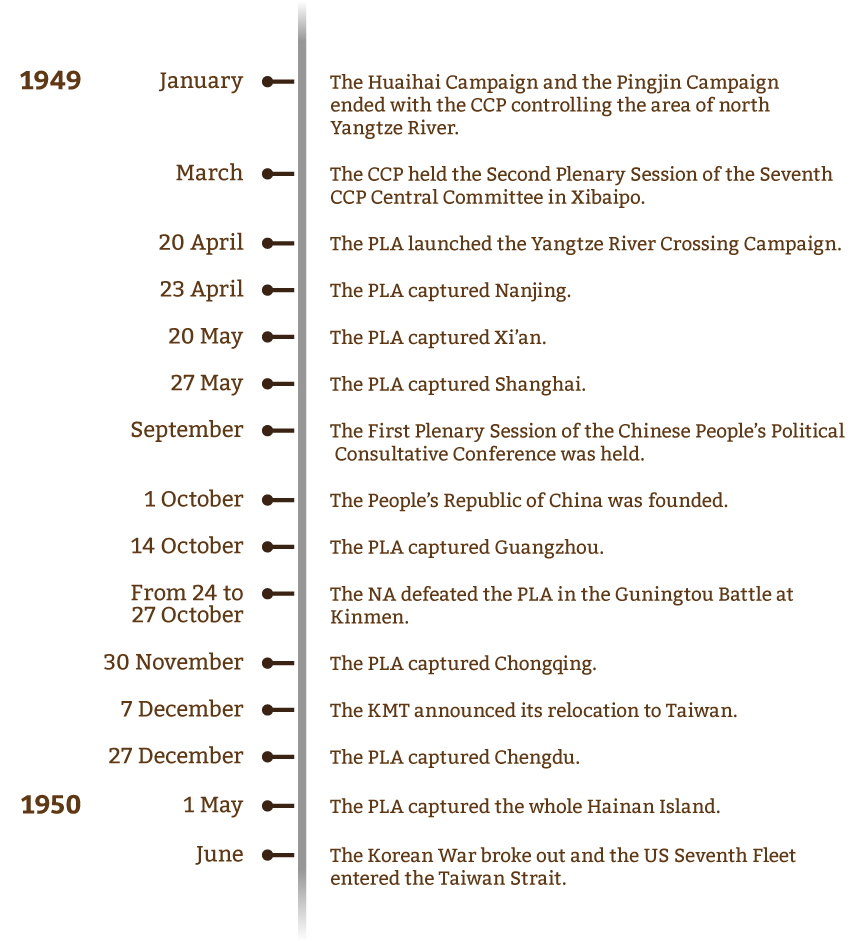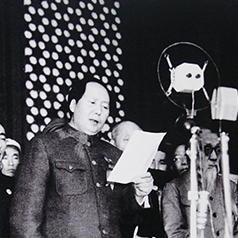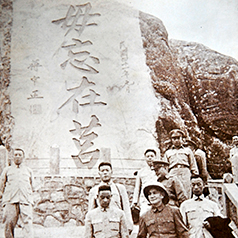After the three major campaigns of the Chinese Civil War between the Kuomintang of China (KMT, 中國國民黨) and the Chinese Communist Party (CCP, 中國共產黨), the situation was turned on its head. Forced by defeats on the battlefield, Chiang Kai-shek (蔣介石) proposed peace talks to his opponents on New Year’s Day 1949. He then swiftly resigned and Li Zongren (李宗仁) succeeded as Acting President. In March 1949, the CCP Central Committee moved to Beiping (北平, now Beijing﹝北京﹞). In April, Zhang Zhizhong (張治中) led the KMT delegation to Beiping for the peace talks with the CCP. However, the CCP’s demands to incorporate the National Army (NA) and punish war criminals were rejected, and the peace talks thus broke down. The People’s Liberation Army (PLA) immediately launched the Yangtze River Crossing Campaign and captured Nanjing (南京), the capital of the National Government, on 23 April 1949.
After the successful Yangtze River Crossing Campaign, the CCP began to establish a new national regime. The First Plenary Session of the Chinese People’s Political Consultative Conference was held from 21 to 30 September 1949. The conference decided to found the People’s Republic of China, a people’s democratic dictatorship led by the CCP. It approved Beijing as the capital city, the March of the Volunteers as the temporary national anthem (and later became the official national anthem), the five-star red flag as the national flag, and the solar calendar was adopted. The conference elected the Central People’s Government headed by Mao Zedong (毛澤東). At 3pm on 1 October 1949, Mao proclaimed the founding of the People’s Republic of China, opening a new chapter in modern Chinese history.
Before and after the founding of the People’s Republic of China, the four major PLA field armies marched into different parts of the country and gradually took control of the entire Chinese mainland. Facing the strong offensive of the PLA, the National Government moved to Guangzhou (廣州) in February 1949, and then to Chongqing (重慶) and Chengdu (成都) successively. Finally, the KMT announced its relocation to Taiwan (台灣) on 7 December 1949. It continued to maintain the banner of the Republic of China, and occupied the islands of Taiwan, Penghu (澎湖), Kinmen (金門), and Matsu (馬祖). After the move, Chiang made a comeback and held power for a long time with his son Chiang Ching-kuo (蔣經國). They learned their lesson and paid more attention to people’s livelihood by carrying out land reforms and developing the regional economy. The division of governance between the two sides of the Taiwan Strait continues to this day.
Footnotes:
1. In December 1947, the National Revolutionary Army (NRA) was renamed the Republic of China Armed Forces, and was generally called the National Army (NA, 國軍﹝Guojun﹞in Chinese).
2. In May 1948, the Nationalist Government was renamed the Government of the Republic of China, and was generally called the National Government (國民政府﹝Guominzhengfu﹞or 國府﹝Guofu﹞in Chinese).







